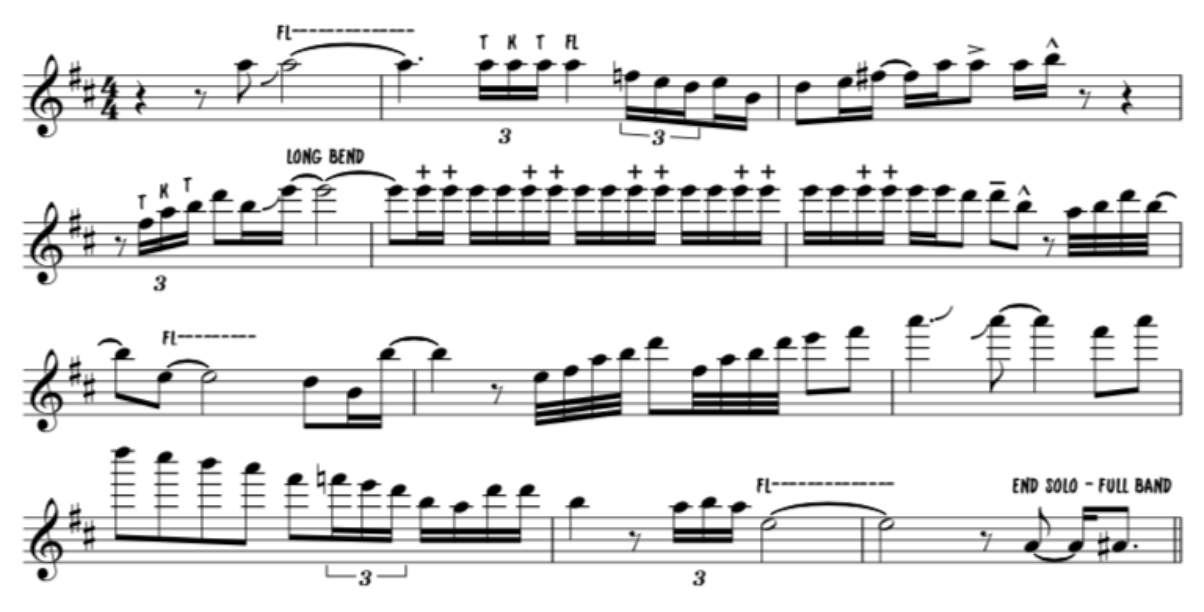Ron Dziubla is the Dean of Performance Studies and Saxophone program faculty member. In this blog, he discusses his experience as a saxophone player and the main tonal saxophone techniques every player should recognize and work into their playing.
The guttural, animalistic sound of the saxophone. That’s what attracted me to the instrument. The huge tones of King Curtis and Jr. Walker floored me, and the tonal techniques they used to get a crowd on their feet and to move a listener to tears inspired me. The growl, the flutter tongue, the double and triple tongue articulations are all a part of my arsenal that coupled with tone, time, and intonation create my saxophone sound. You can replicate scales and whole notes with samples, but you can’t imitate a personal and unique saxophone sound consisting of the notes that exist between the notes.
On my first day at the University of Miami School of Music, I heard all of my fellow saxophone students playing with amazing technique, playing faster than I could imagine. After I got over the shock of how good everyone was, I realized that everyone sounded the same.
That led me to my quest for my own personal saxophone sound, which then led me to my realization that it wasn’t the number of notes that inspired me. It was an artist’s selection of notes, the sound, and what I like to refer to as “the notes between the notes.” King Curtis and Jan Garbarek became and still are my saxophone heroes. Over the years, I managed to gather all of the information from my classes and private lessons, listened and transcribed the solos that moved me, and put it all to use in my professional work on stage and in the studio.
I have recorded solos for artists such as the Rock and Roll Hall of Fame guitarist Duane Eddy, Latin pop stars such as Chayanne and Franco de Vita, country star LeAnn Rimes, R&B artist Nick Waterhouse, and most recently the guitar great, Joe Bonamassa.

Blog Post
"*" indicates required fields
By submitting this form, I authorize Musicians Institute (MI) to make or allow the placement of calls, emails, and texts to me at the phone number that I have provided, including through the use of automated technology, or a prerecorded or artificial voice. I understand that I am not required to provide my phone number as a condition of purchasing any property, goods, or services. I agree to the terms of MI’s Privacy Policy. MI will not sell or rent your information to third parties, and you may unsubscribe at any time.
The only thing that any artist has is their unique voice, and it isn’t something they’re born with. It’s something they need to work on. So my advice: Get to the basics, find your influences, get to what moves you, learn it like it’s yours, and then turn it into you.
Let’s check out some sax solos that feature some of the “between the notes” techniques that make the saxophone the saxophone.
The Growl
You can hear Clarence Clemmons demonstrating the growl on Lady Gaga “Edge of Glory.” Clarence’s sound and presence drove Bruce Springsteen and the E-Street Band for years, and his solo on “Born to Run” is arguably one of the best rock solos of all time. For now, let’s listen to his work with Lady Gaga on her song “The Edge of Glory”:
I love the rock saxophone on the pop tunes. The solo starts in a break from the intensity of the rhythm track. The solo builds higher with beautiful growls in the tone, especially apparent at 3:37 and 3:42, besides other spots. The horn brings us back to the groove and into another break before returning at the end to build the tune to its completion.
The Flutter Tongue
Jr. Walker! We could talk about the Jr. Walker classic “Shotgun,” but let’s stay on the rock and pop tip and talk Foreigner’s “Urgent.”
Flutter tongue and altissimo! That’s Jr. Walker. He plays a solo that’s melodic, which builds on itself. You can sing the solo as it carries the song over the half-way point to the end. At the end of the solo, you know that people are getting up and going crazy! Let’s not forget the great Mark Rivera, who plays the sax parts on the tune–in a most “urgent” manner that serves the tune perfectly.
Double Tongue/Triple Tongue Articulations
This is my saxophone hero King Curtis with the inimitable Aretha Franklin on one of her greatest hits, “Respect.”
You know that if you’re Aretha Franklin’s musical director and her saxophonist on stage and in the studio, you’ve got something serious going on. I love the articulations he uses, what sounds to be double tonguing on the solo. It’s textbook King Curtis, much like the beginning of his solo on the classic “Memphis Soul Stew.” His huge tenor sound is what drove me to this style of playing, that “Texas tenor saxophone sound.” If you’re playing this tune live, be sure to know your theory on this one. The solo starts a tritone away from the key of the tune.
Let’s put it all together
This is me, rocking a solo for Joe Bonamassa on the Live at the Greek Theatre album. The truth? Yeah, I knew what I was going to play. I’m not going to leave one chorus of solo to chance in front of a packed house at the Greek…I’ve always been a “one foot in academia and one foot on the road” type of musician.
Below, I’ve included a transcription of my solo on “Cadillac Assembly Line” with Joe Bonamassa with the techniques highlighted:

The tonal techniques of the growl, the flutter tongue, the double and triple tongue articulations. In the future, we can talk more about how we create those sounds on the horn. For now, you can find me at www.rondziubla.com and as the Dean of the School of Performance Studies at Musicians Institute in Hollywood, California.
If you’re interested in learning more, please visit our Horn program page on MI’s website or email [email protected] for any questions.

